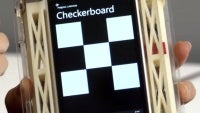Microsoft shows off touch-screen prototypes that let you feel actual clicks and frictions

Microsoft shows off touch-screen prototypes that let you feel actual clicks and frictions
No matter how sharp and colorful your smartphone or tablet's display is, underneath your fingers, working on it still feels like touching a mirror - cold, flat, lifeless, imprecise... and a little greasy. Screens with tactile feedback that emulate the sense of keyboard buttons have been in the works for a while, but this is a complex endeavor reserved for a more technologically adept future. Which doesn't stop Microsoft from being on the case as we speak. Redmond's research arm presented a very interesting publication and video that look deeply into tactile touch-screen technology that is in development in Asia. It's working prototypes stuff, not designer concepts.
MS researcher Hong Tan has a vision - she wants to "fully engage the sense of touch in user-device interaction" . A sense that's missing from the two-dimensional way in which we currently interact with our phones and tablets. We might be getting the occasional vibration or issuing a voice command here and there, but we're not getting a physical sensation as we press buttons and drag folders. Adding tactile feedback won't make computing more efficient, but it will certainly make it a more enjoyable, engaging experience.
Tan has been working to achieve that for 13 years, before she joined Microsoft Research in 2011. Her "Human-Computer Interaction" group has already created prototype screens that have layers of material under their flexible glass. The material bends under electric current, and the glass bends slightly as well, which ends up simulating a button press. Other accomplishments rely on alternating voltage to the screen, which changes the friction between it and the fingertips. This way, sticky, smooth, and rough surface sensations are being simulated. One of the prototype tablets has a screen, one area of which feels like sandpaper, and another has a notch for scrolling.
Interesting and novel as it is, the haptic technology lacks clear consumer applications and 'killer apps' to bring it to the mainstream - although the game of tactile Checkerboard played on a Lumia looks pretty cool, no? Of course, this doesn't mean we won't have smartphones and tablets that simulate the texture of fabrics when we look up clothes online, or shuffle their screens under our fingers to simulate button taps and clicks - it's just a matter of time and combined engineering effort.

No matter how sharp and colorful your smartphone or tablet's display is, underneath your fingers, working on it still feels like touching a mirror - cold, flat, lifeless, imprecise... and a little greasy. Screens with tactile feedback that emulate the sense of keyboard buttons have been in the works for a while, but this is a complex endeavor reserved for a more technologically adept future. Which doesn't stop Microsoft from being on the case as we speak. Redmond's research arm presented a very interesting publication and video that look deeply into tactile touch-screen technology that is in development in Asia. It's working prototypes stuff, not designer concepts.

source: Microsoft Research
Follow us on Google News












Things that are NOT allowed:
To help keep our community safe and free from spam, we apply temporary limits to newly created accounts: